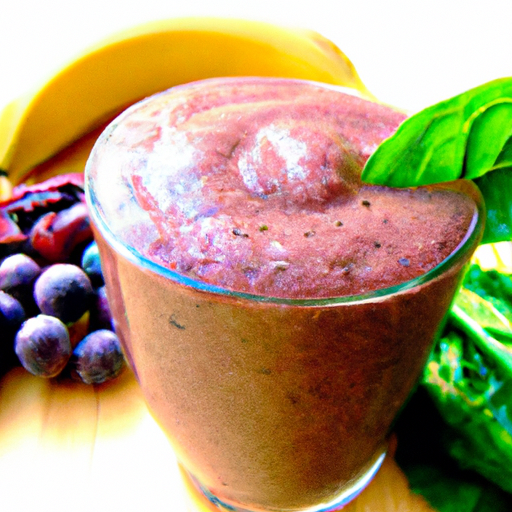Are you looking for a simple and tasty way to boost your health and well-being? Look no further than Tastepan’s collection of nutrient-rich smoothie recipes. In this article, we will explore the world of delicious and healthy smoothies that will nourish your body without compromising on flavor. Whether you’re a seasoned smoothie enthusiast or just starting your journey into the world of blended beverages, we have the perfect recipes and expert advice to help you create smoothies that are both nutritious and delicious. Get ready to embark on a flavorful and healthy adventure with Tastepan’s nutrient-rich smoothies.

Choosing the right ingredients
When it comes to creating nutrient-rich smoothies, choosing the right ingredients is key. Here are some essential components to consider:
Fruits
Fruits not only add natural sweetness to your smoothies but also provide a host of vitamins, minerals, and antioxidants. Options like berries, bananas, mangoes, and pineapple are popular choices that offer a range of health benefits.
Leafy greens
Leafy greens are a fantastic addition to any smoothie as they are packed with essential nutrients. Spinach, kale, and Swiss chard are excellent options that add a vibrant green color and provide an array of vitamins and minerals.
Protein sources
Including protein in your smoothies can help keep you satisfied and support muscle recovery. Options like Greek yogurt, tofu, or a scoop of protein powder, whether plant-based or animal-based, can be added to amp up the protein content.
Healthy fats
Adding healthy fats to your smoothies can help enhance the creaminess and provide satiety. Avocado, nut butters like peanut or almond butter, and chia or flaxseeds are great choices that offer a dose of heart-healthy fats.
Superfoods
Superfoods are nutrient powerhouses known for their exceptional health benefits. Consider adding ingredients like spirulina, chlorella, or greens powders to boost the nutritional profile of your smoothie. These extras can provide additional vitamins, minerals, and antioxidants.
Adding the perfect liquid base
The liquid base of your smoothie serves as the foundation and helps create the desired consistency. Here are some options for the perfect liquid base:
Water
Water is a simple and hydrating choice for those looking to keep the calorie count low. It allows the other ingredients to shine and is an ideal base for those watching their sugar intake.
Plant-based milk
Plant-based milk options like almond milk, coconut milk, or oat milk add creaminess and subtle flavor to your smoothies. They also provide some extra nutrients, especially if fortified with vitamins like B12 or D.
Coconut water
Coconut water adds natural sweetness and electrolytes to your smoothie. It’s a refreshing choice for those looking for a tropical twist and can help replenish essential minerals.
Green tea
Green tea is a great option to add an antioxidant boost to your smoothie. Brewed and chilled green tea not only provides a subtle flavor but also adds catechins that have been linked to various health benefits.
Fresh fruit juice
Freshly squeezed fruit juice, such as orange or apple juice, can add a vibrant and natural sweetness to your smoothie. While it does contain natural sugars, it also offers a range of vitamins and minerals.

Boosting the nutrition with supplements
To take your smoothie to the next level in terms of nutrition, consider incorporating these supplements:
Protein powder
Protein powder is an easy and convenient way to boost the protein content of your smoothie. Whether you prefer whey, plant-based, or collagen protein, adding a scoop can support muscle recovery and keep you full.
Greens powder
If you struggle to consume enough leafy greens, a greens powder can be a game-changer. Packed with concentrated nutrients, adding a scoop to your smoothie will ensure you get your daily dose of vitamins and minerals.
Flaxseed or chia seeds
Flaxseed and chia seeds are excellent sources of omega-3 fatty acids and fiber. Grinding them or soaking them beforehand allows your body to absorb their nutrients better, making them a valuable addition to your smoothie.
Spirulina or chlorella
Spirulina and chlorella are nutrient-dense algae that offer a wide array of health benefits. These superfoods are packed with protein, vitamins, and minerals, and adding a teaspoon or two to your smoothie can provide a powerful nutritional boost.
Probiotics
For gut health and digestion, consider adding a probiotic supplement or a spoonful of yogurt containing live cultures to your smoothie. Probiotics help support a healthy gut microbiome, which plays a crucial role in overall well-being.
Enhancing the flavor with natural sweeteners
Sometimes, you may want to add a touch of sweetness to your smoothie. Here are some natural sweeteners to consider:
Medjool dates
Medjool dates are a delicious and nutritious sweetener option for your smoothies. They add natural sweetness and provide fiber, potassium, and essential minerals.
Honey or maple syrup
Honey and maple syrup are natural sweeteners that add a distinct flavor to your smoothie. While they do contain natural sugars, using them in moderation can provide a touch of sweetness.
Bananas
Bananas not only add creaminess to your smoothie but also act as a natural sweetener. They are high in vitamins, minerals, and fiber, making them a nutritious way to enhance the flavor.
Stevia
Stevia is a plant-based zero-calorie sweetener that can be used sparingly to add sweetness without the added sugar. It’s a suitable option for those watching their sugar intake or looking for a low-calorie alternative.
Pitted prunes
Pitted prunes are a lesser-known natural sweetener that can add depth and richness to your smoothie. They are also high in fiber and contain essential minerals like potassium and magnesium.

Achieving the perfect texture
The texture of your smoothie can greatly impact your enjoyment. Here are some ingredients that can help achieve the perfect consistency:
Frozen fruits
Using frozen fruits instead of fresh ones can make your smoothie thicker and icier. They act as natural thickeners while adding a refreshing element to your drink.
Avocado
Adding avocado to your smoothie can contribute to a creamy and velvety texture. Avocados are rich in healthy fats and provide a smooth consistency without overpowering the flavor.
Greek yogurt
Greek yogurt is a versatile ingredient that not only adds a tangy flavor but also creates a thick and creamy texture. It’s also an excellent source of protein, calcium, and probiotics.
Silken tofu
Silken tofu is a plant-based alternative to Greek yogurt that offers a similar creamy texture. It’s a great option for vegans or those looking to incorporate more plant-based protein into their diet.
Peanut or almond butter
For a nutty flavor and added creaminess, consider including peanut or almond butter in your smoothie. These spreads provide healthy fats and richness to the texture, making them a delicious addition.
Creating combinations for specific health benefits
Tailoring your smoothie to specific health goals can help maximize its nutritional impact. Here are some combinations for various health benefits:
Energy-boosting smoothies
To kickstart your day or energize for a workout, combine ingredients like banana, spinach, peanut butter, and a dash of espresso to create an energy-boosting smoothie.
Immune-boosting smoothies
For a robust immune system, combine ingredients like orange juice, pineapple, ginger, turmeric, and a scoop of greens powder. These ingredients are rich in antioxidants and vitamins that support immune health.
Digestive health smoothies
To promote digestion and gut health, combine ingredients like Greek yogurt, papaya, ginger, and flaxseed. These ingredients provide probiotics, fiber, and enzymes that aid in digestion.
Detoxifying smoothies
To aid in detoxification, combine ingredients like kale, cucumber, lemon, parsley, and spirulina. These ingredients support the body’s natural detoxification processes and provide a range of vitamins and minerals.
Skin-nourishing smoothies
For healthy and glowing skin, combine ingredients like berries, spinach, almond butter, and collagen protein powder. These ingredients offer antioxidants and nutrients that promote skin health.
Blending techniques and equipment tips
To ensure that your smoothie comes out perfectly blended and with the desired consistency, consider the following techniques and equipment tips:
Choosing the right blender
Investing in a high-quality blender with enough power and sharp blades is essential. Look for a blender that can handle ice, frozen fruits, and tough ingredients to ensure a smooth blend.
Layering ingredients for optimal blending
To prevent clumping or uneven blending, it’s important to layer your ingredients properly. Start with your liquid base, followed by leafy greens, fruits, powders, and finally, any frozen ingredients on top.
Using frozen ingredients
Using frozen fruits, vegetables, or ice cubes can help create a thicker and colder smoothie. This is especially useful if you prefer a frosty texture or want to avoid diluting your smoothie with ice.
Blending in stages for a smooth consistency
To ensure all ingredients are fully incorporated and your smoothie is smooth, blend in stages. Start with the liquid base and leafy greens, then gradually add other ingredients while blending until you achieve the desired consistency.
Experimenting with different textures
Don’t be afraid to experiment with different textures in your smoothies. You can vary the thickness by adjusting the amount of liquid or add crunchy toppings like granola or nuts for extra texture and satisfaction.
Meal replacement smoothies
Smoothies can be a convenient and healthy meal option. Here’s how to create a nutrient-dense meal replacement smoothie:
Balancing macros and micros
Aim to include a balance of macronutrients (carbohydrates, protein, and fats) in your meal replacement smoothie. Consider adding fruits, a protein source like Greek yogurt or protein powder, and ingredients like avocado or nut butter for healthy fats.
Including fiber for satiety
To keep you full and satisfied, it’s important to include fiber in your meal replacement smoothie. Ingredients like chia seeds, flaxseed, or leafy greens are excellent sources of fiber that promote satiety.
Adding enough protein
Protein is essential for muscle repair and satiety, especially in a meal replacement smoothie. Aim to include a protein source like Greek yogurt, tofu, or a scoop of protein powder to meet your protein needs.
Incorporating healthy fats
Including healthy fats in your meal replacement smoothie helps provide a steady source of energy and helps keep you satisfied. Add ingredients like avocados, nut butters, or a splash of coconut milk to incorporate healthy fats.
Optimizing nutrient density
To make your meal replacement smoothie as nutrient-dense as possible, include a variety of fruits, leafy greens, and superfoods. This ensures you’re getting a wide range of vitamins, minerals, and antioxidants.
Preparation and storage tips
Prepping and storing your smoothie ingredients ahead of time can save you time and ensure you always have a healthy option available. Here are some tips:
Batch prepping ingredients
Consider prepping ingredients in advance, such as cutting and portioning fruits or measuring out protein powder or greens powder. This helps streamline the smoothie-making process and saves time during busy mornings.
Freezing smoothie packs
To make smoothie preparation even more convenient, create freezer-friendly smoothie packs. Simply pre-portion your ingredients into individual freezer bags or containers and freeze. When you’re ready to make a smoothie, just blend the contents of a pack with your liquid base.
Investing in quality storage containers
Invest in high-quality storage containers that are airtight and leak-proof. Glass jars or BPA-free plastic containers are great options for storing prepped ingredients, leftovers, or even ready-to-go smoothies.
Avoiding oxidation
To prevent your smoothie from oxidizing and losing nutritional value, store it in an airtight container and consume it as soon as possible after blending. Alternatively, a quick squeeze of lemon juice can help slow down oxidation.
Refreshing smoothies to enjoy later
If you plan to enjoy your smoothie later in the day, give it a quick shake or blend before drinking to refresh the flavors and maintain a consistent texture.
Enjoying smoothies as a part of a balanced diet
While smoothies can be a nutritious addition to your diet, it’s essential to enjoy them as part of a balanced eating plan. Here are some factors to consider:
Meal planning with smoothies
Integrate smoothies into your meal planning by considering their nutritional profile alongside your other meals and snacks throughout the day. This ensures you’re getting a variety of nutrients and a balanced intake of protein, carbohydrates, and fats.
Including other food groups
Smoothies can be an excellent vehicle for incorporating other food groups into your diet. Consider adding a handful of nuts, a side of whole grains, or a serving of protein alongside your smoothie to create a well-rounded meal.
Watching portion sizes
Although smoothies can be delicious and nutritious, it’s important to watch portion sizes, especially if you’re using calorie-dense ingredients like nut butters or avocados. Be mindful of the overall calorie content and tune in to your body’s hunger and fullness cues.
Listening to your body’s needs
Everyone’s nutritional needs are unique, so it’s important to listen to your body and make adjustments accordingly. If you find that smoothies aren’t keeping you satisfied, consider adding more protein, fiber, or healthy fats to help curb hunger.
Keeping the overall nutritional profile in mind
While smoothies can be packed with nutrients, it’s important to ensure that your overall diet is balanced and includes a variety of whole foods. Smoothies should be seen as a supplement to a healthy eating plan rather than a replacement for a diverse range of ingredients.
By following these guidelines and incorporating nutrient-rich ingredients, you can create flavorful and healthy smoothies that nourish your body and support your well-being. So go ahead, get creative, and blend up your perfect smoothie masterpiece!

